Memory in Psychology Pdf (Part-3)
This article focuses on Working memory. Memory in Psychology Pdf (Part-3) We will talk about how manipulation of information is accomplished in Working memory. We will also discuss the experiments that have been conducted using imaging techniques and ERPs to study Working memory. We have been talking about aspects of memory in our recent articles we covered sensory memory in the first of the series and we talked about short-term memory in the last article today I am going to talk to you about another aspect of short-term memory let us say a re-thought version of what short-term memory will be doing and the name given to this is called Working memory.
Alan David Baddeley
Now the concept of Working memory as opposed to short-term memory was put forward by Alan David Baddeley, Alan David Baddeley one of the most influential researchers in memory basically proposed that short-term memory processes must be dynamic and they must also consider the number of components that can function separately now one of the ideas why Alan David Baddeley must have thought so is that shorter memory or let us say if you liken it to the ram of your computers it deals with a lot of information it deals with a variety of information and it manipulates these varieties of information whereas the whole concept of short-term memory might be taken to think that it just passively stores information for some time before it passes on to the long-term memory.
Working Memory
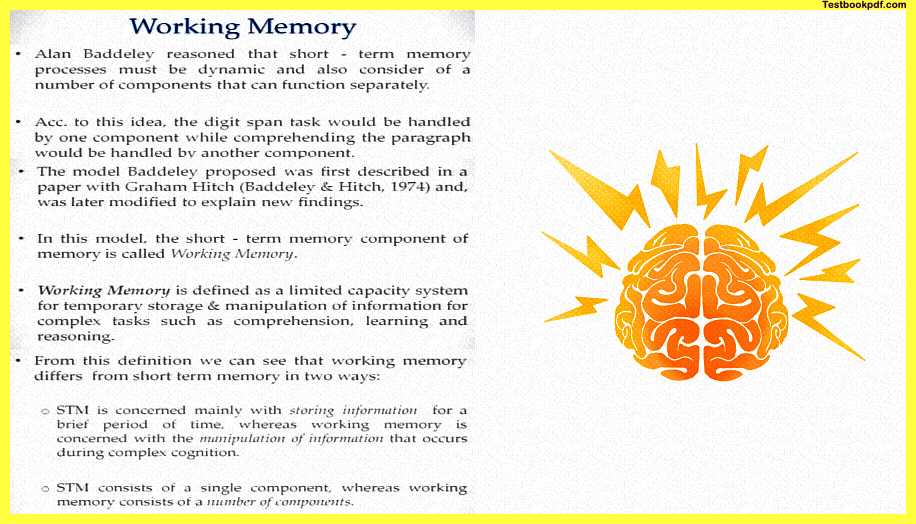
So these were some of the conceptual differences which probably led to the formation of this concept of Working memory according to this idea this background can be probably proposed and Alan David Baddeley might have thought that the digit span task must be handled by a separate component altogether while comprehending of the paragraph if you remember Spakes study as well might be handled by a different component the model badly was proposing was first described his paper by graham hitch and the paper was written in 1974 badly in the hitch and it was later modified.
So later versions and more recent versions have also come of that model but this model basically says that short-term memory it has a very specific component called Working memory and Working memory they define as a limited capacity system for temporary storage and manipulation of information and this temporary storage and manipulation of information is basically dependent on complex tasks such as comprehension learning and reasoning whatever the person might be called upon to do whatever task you have at hand you probably take it to what is called Working memory from this definition we can say that we are actually talking of a more dynamical system as opposed to what the initial conception of short-term memory was so two differences might be pointed out that while short-term memory is concerned primarily with storing information manipulation of information is basically the job of Working memory also short memory has been thought of as consisting of a single component while in Working memory you can think of different independent components different components Working in an independent fashion though they might be interconnected as well.
Visuospatial Sketchpad
So Working memory as such again given this new conception accomplishes the manipulation of information through the action of three components as proposed by Alan David Baddeley the components, the phonological loop the Visuospatial Sketchpad, and the central executive phonological loop are supposed to consist of two components it consists of the phonological store which is a limited capacity stored and holds information for only a few seconds and the articulatory rehearsal process which is responsible for the rehearsal that can keep items in the phonological store from decaying suppose somebody told you a phone number to memorize and before you find a pen or before you find your cell phone to quickly type that number into you might want to keep repeating that.
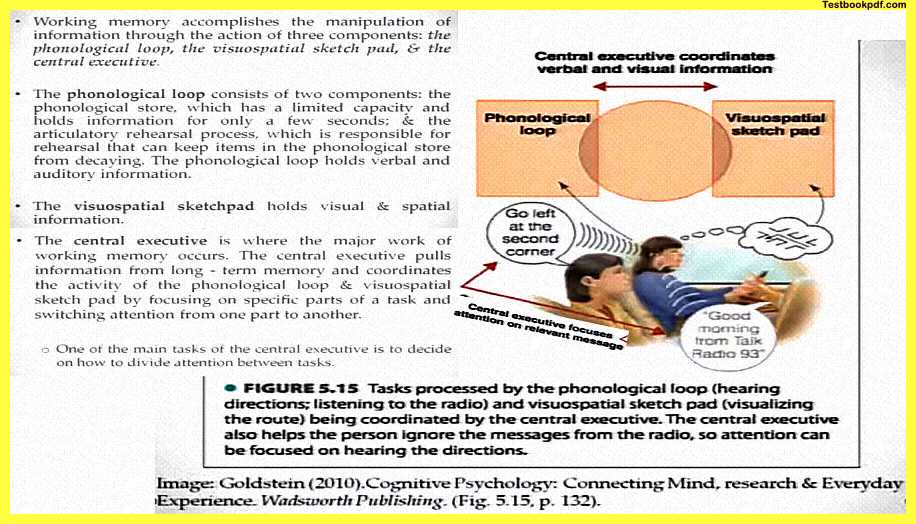
So that the information this verbal information or let us say this phonological information is maintained in the phonological stuff this phonological store as i already said holds verbal that is language like and auditory information that is the one of sounds the Visuospatial Sketchpad on the other hand holds visual and spatial information anything about the visual world anything about location of objects those kind of things if you are given a task of keeping three bags in the boot of your car and you have to just you have just been asked that do you think these three bags will fit in the boot of my car you might want to really visualize what the boot of your car looks like and try and fit these things in an imaginative fashion before saying yes to this question this kind of information, this kind of manipulation is basically supposed to be achieved via the use of this Visuospatial Sketchpad the third component basically is the central executive wherein the major work of the Working memory occurs the central executive pulls information from the long-term memory and coordinates.
Phonological Loop
The activity of the phonological loop and the Visuospatial Sketchpad by focusing on specific parts of a task and switching attention from one part of the task to another suppose its like a desk secretary where you go and give the task and the secretary decides where this particular file needs to go to whether it needs to go to phonological loop or it needs to go to the Visuospatial Sketchpad so one of the main tasks also of this phonological loop is to decide how to divide attention between two tasks.
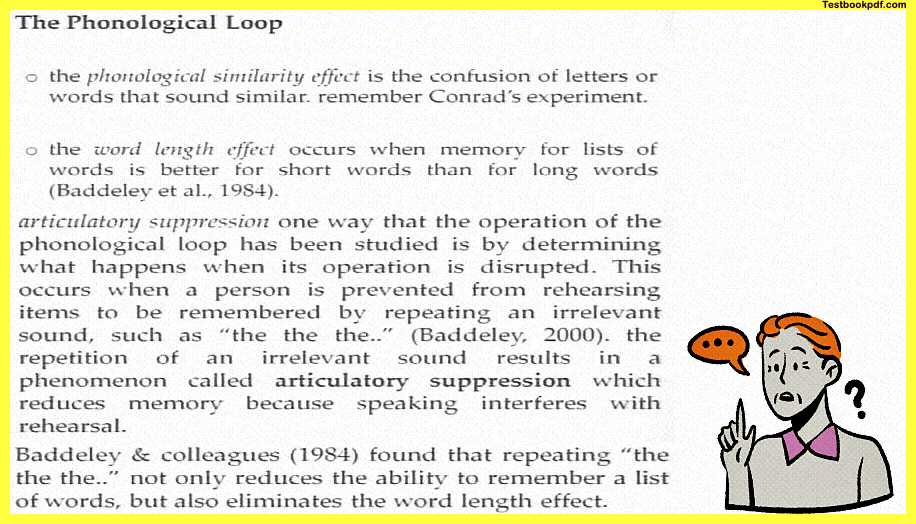
So if you are given a task to Working memory the central executive is the process that will decide whether and how this task is supposed to be handled which parts of the task will be handled by the phonological loop and which parts of this task will be handled by the Visuospatial Sketchpad herein you can see a graphic representation of the phonological loop and the Visuospatial Sketchpad you will see that the circle which is the central executive it is kind of coordinating between those these two things an example given for in this figure by goldstein is basically when you are kind of listening to instructions and still driving the car you are listening to instructions and maintaining them in your phonological store while you are actually visually and spatially coordinating the car on the different paths according to whatever instructions are being given to you so this is one very dynamic kind of an example wherein you are basically using both the phonological loop and the Visuospatial Sketchpad at the same time in the same task let us elaborate a little bit on the phonological loop what are the different effects what are the research findings in this.
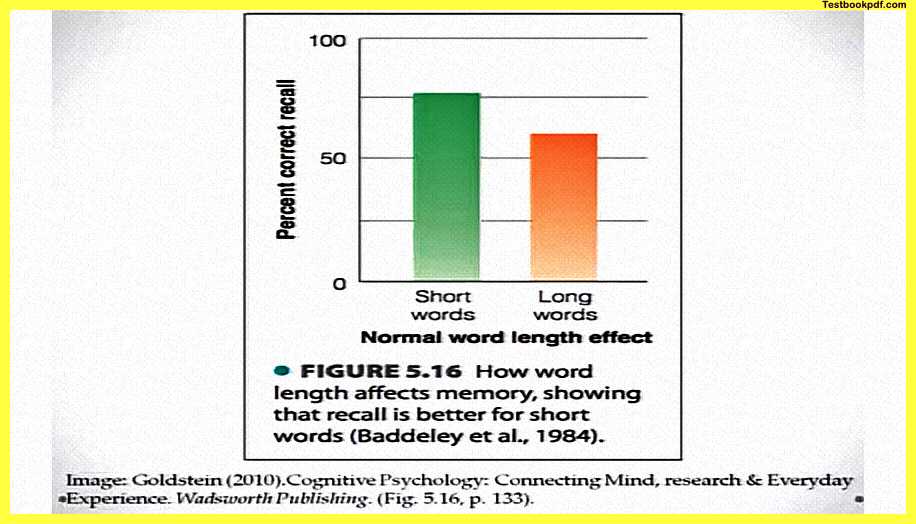
So the phonological loop one of the major findings in the related phonological loop is called the phonological similarity effect which is basically that if you are kind of trying to maintain letters or sounds which are very very similar those might be confused with each other if you remember Conrad’s experiment he did this experiment with the people who were asked to remember who were asked to remember letters of the english alphabet and they were confusing they were making some mistakes but more importantly the mistake was basically being made on those letters which sounded very similar to each other like the s and the f example that was there also another effect about the phonological loop is the word length effect word length effect occurs when memory for the list of words is better for short words and than for long words if i give you a list of words to remember and some are like three or four letter words and the others are five or six or seven letter words may be then the typical finding is that the memory for shorter words is better than the memory for longer words another important phenomena is called articulatory suppression articulatory separation is one of these ways where in the operation of the phonological loop can be disrupted.
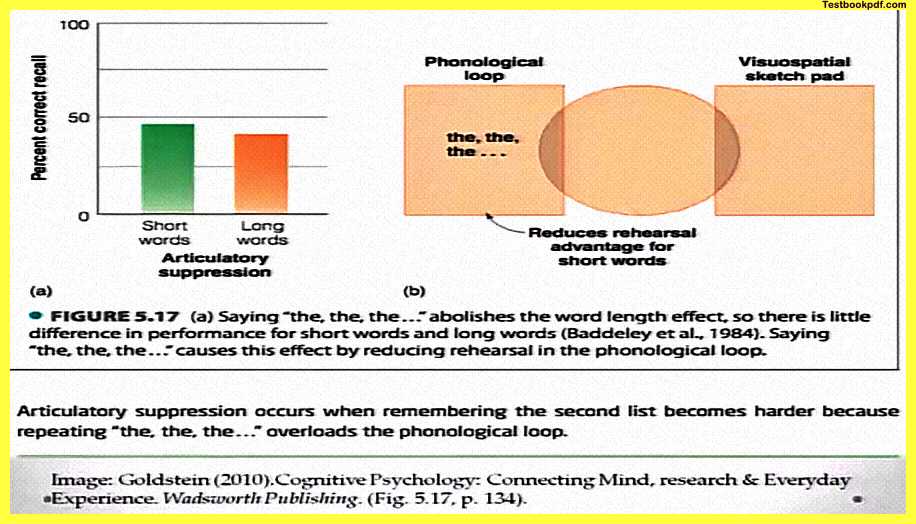
So this occurs when a person is prevented from rehearsing some verbal information by asking them to repeat an irrelevant sound if i have to ask you to remember few phone numbers maybe a list of phone numbers but i say okay you have to remember this still by till during remembering this you still have to keep saying any air driven sound like whatever so what happens here is that because you are kind of repeating these irrelevant sound it blocks the rehearsal space for the numbers that i have given you and that results in what is called and what has been described as articulatory suppression you cannot maintain too much verbal information at the same time in the phonological loop that is why this particular phenomenon occurs barely and colleagues they basically found and they did this very simple experiment that repeating the, the, the, continuously not only reduces the ability to remember a list of words but also eliminates the word length effect here you can see the typical word length effects their percentage recall of shorter words is much higher than longer words but when participants are asked to repeat the, the, the, continuously you see that the advantage for the shorter words is completely or almost gone and their total percentage of recall is almost equivalent to what it is for the longer words coming to the Visuospatial Sketchpad.
The Visuospatial Sketchpad
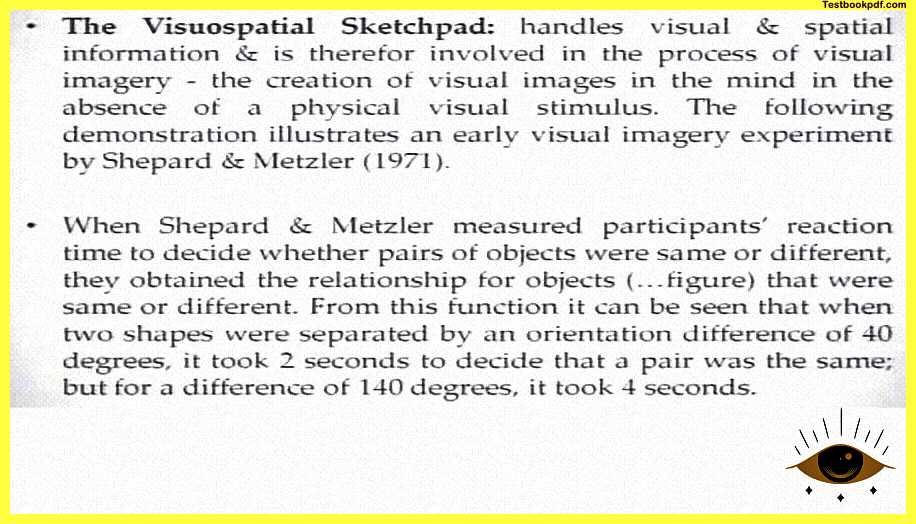
Now the Visuospatial Sketchpad as I said handles visual and spatial information and is therefore involved in the process of visual imagery the example I gave if you have if somebody asks you whether these three or four bags will fit in the boot of your car you will have some memory of how the boot of your car looks like what are its dimensions and what you will try to do is you will try to fit each of these bags imaginably in an imaginative way in your car and you will say that ok maybe this bag will be put horizontal this bag will be put vertically maybe I will slant this bag over this one and this is how it will fill up so this is basically a typical example of visual imagery and visual imagery is obviously achieved by what is called the Visuospatial Sketchpad.
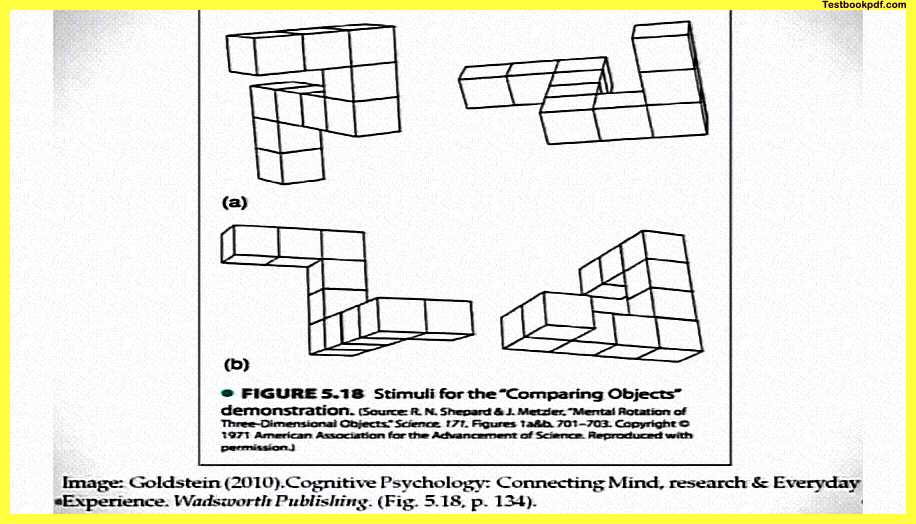
Now another very interesting and very famous experiment about visual imagery was done by Shefford and Metzler in nineteen seventy-one now Schaefer and Mercedes measured participants’ reaction time to decide whether a pair of objects were the same or different so they made these imaginary objects and the task of the participants was to tell whether the two objects are the same or they are different so from this function they are trying to see how the partition should perform it could be seen that when two shapes were separated by an orientation difference of around 40 degrees it took two seconds for the participants to decide that the pair was same and but for a difference of 140 degrees it took around four seconds so the whole idea is that say for example show you the figures are like this.
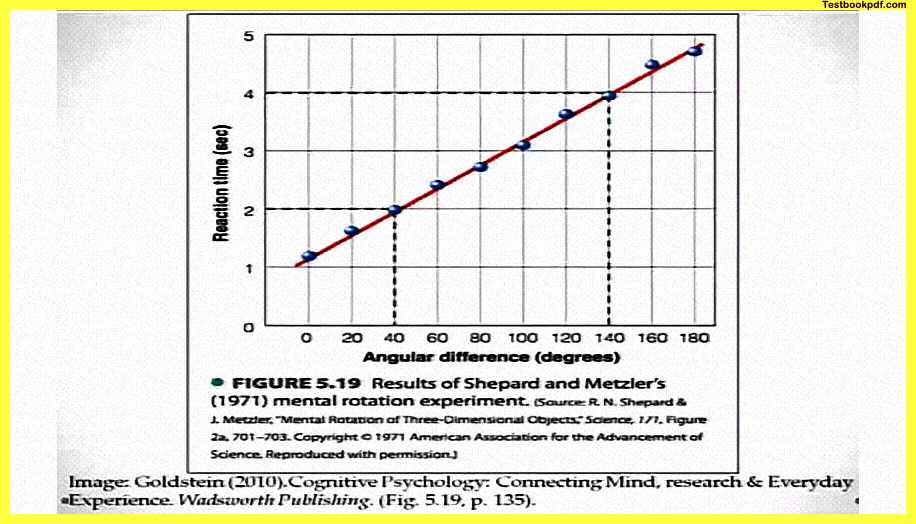
So if i give you one pair in panel a and the other pair in panel b what you have to do to achieve this task is basically try and mentally rotate the first figure in panel a see whether it resembles the other figure in panel b or say for example if you to try and rotate the first figure in panel b and see whether it matches the second figure in panel b so you will have to maintain this in your memory and then rotate it and then try and match it with this figure with the second figure and here you can see as the number as the angular difference between a and b as orientation differs the time taken to recognize or the time taken to say whether it is same or different also increases based on these findings shefford and medzler concluded that participants were solving the problem by rotating the image of one of the objects in their mind a phenomenon which was later named mental rotation now lee brooks also did some experiment in which he demonstrated how the interference can affect the operation of the visual spatial sketch path so what he did was he the task is something like this there are two figures here 5.20 5.21 from goldstein’s cognitive psychology.
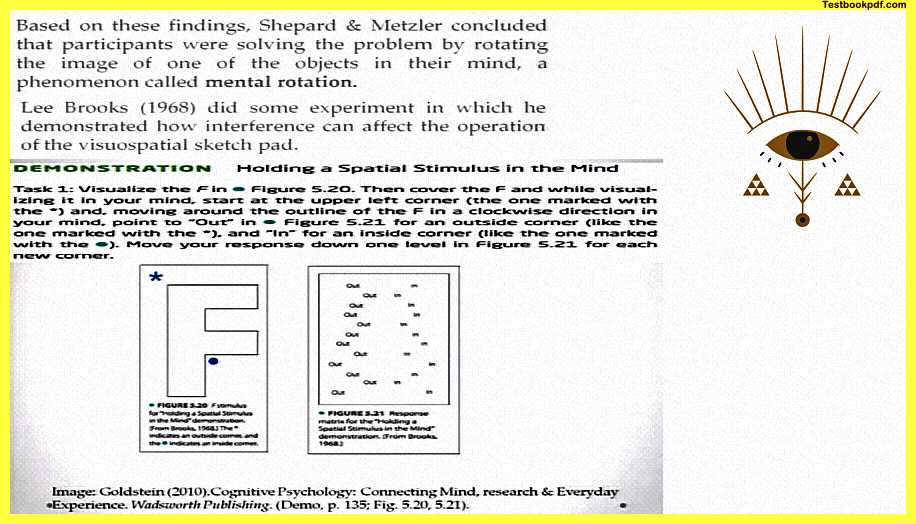
Now the task is basically to visualize the figure f in 5.20 maintain it then cover it while visualizing this in your mind still and then what you do is you start at the left most corners left top corner and actually you move around to the around the outline of the f and what you have to do is for an outside corner says in and for an inside corner say out so you have to kind of move around the trajectory of this figure and say in or out take that decision now a different task could also be that you visualize the f again but this time you move around the outline of the f in a clockwise direction and in your mind say out if the corner is in an outside corner in if the corner is an inside corner remember you are doing the opposite of this in the last task they asked many people to do this task and they found that most people find the pointing task much more difficult the reason is that holding the image of a letter and pointing are both visual-spatial tasks.
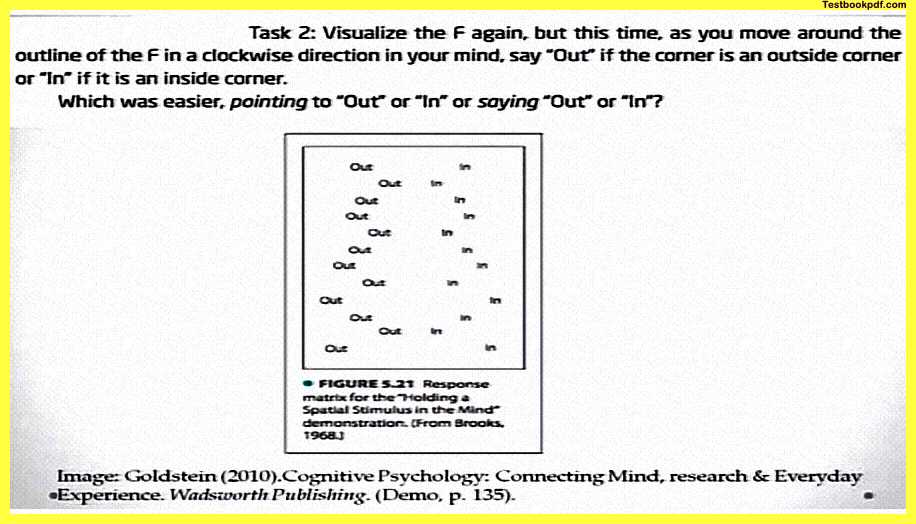
So the Visuospatial Sketchpad in that sense becomes overloaded in contrast to saying out or in an articulatory task that is handled by a phonological loop so speaking does not interfere with visualizing f if you remember again, I will remind you in this first task you have to mentally point out or in where in this one you have to say out of it so that is why in the second one the Visuospatial Sketchpad does not really get overloaded because some of the information is verbal and is shifted to the phonological store now coming to the central executive now the central executive is the component that makes the Working memory actually Working you are describing that sometime back so it is the control center of the Working memory system its mission is not to store information but to coordinate how information is going to be used by the two Working components.
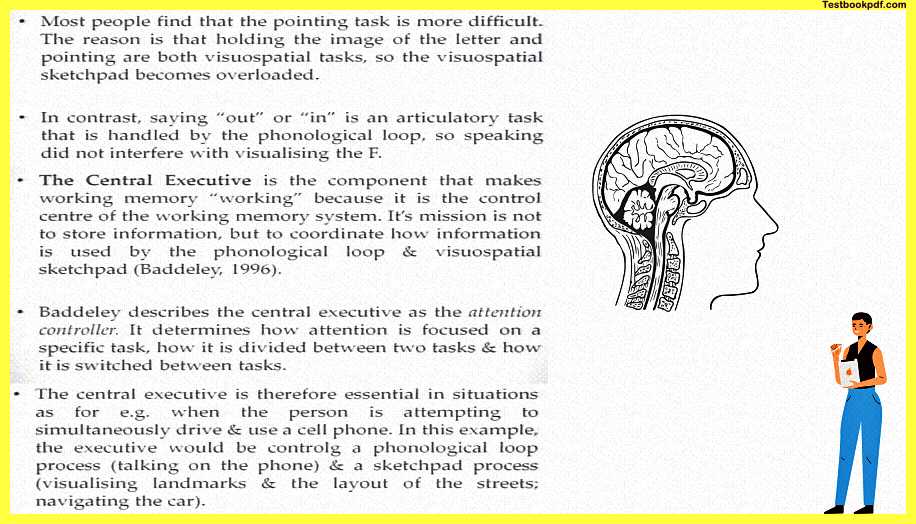
Now badly describes the central system as the attentional controller he says that this one determines how attention will be focused on a specific task and how it will be divided into two tasks depending on the task demand and how easy or difficult the task will be now the central executive is therefore essential in situations say for example if a person is attempting to simultaneously drive and use a cell phone not that it is advisable to do so somebody is trying to do that then a central executive is basically it will spring into action.
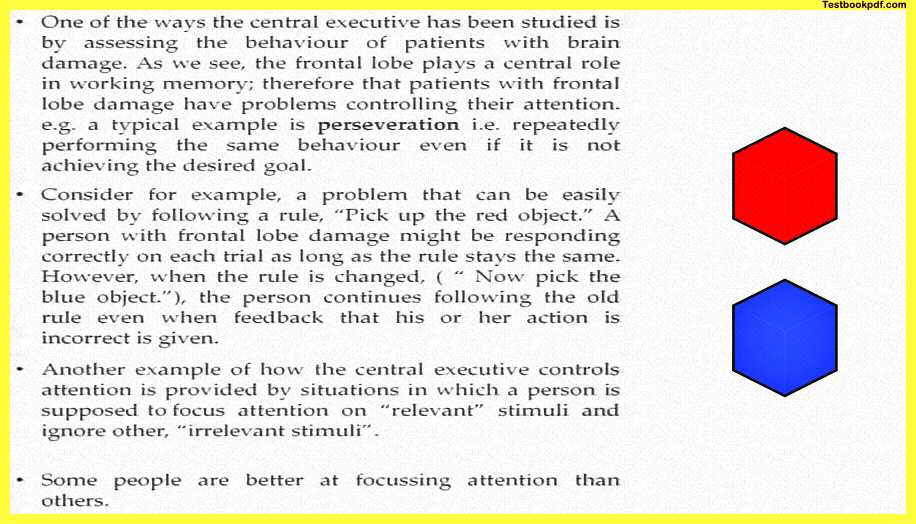
now in this example the central executive would be controlling the phonological loop process that is talking in the phone the sketchpad will basically be doing the navigation which is basically identifying the landmarks and the layout of the streets and taking the car off one of the ways the central executive has been studied is by assessing the behavior of patients with brain damage as we have seen the frontal lobe is supposed to play a central role in Working memory, therefore, patients with frontal lobe damage have found to be having more problems with attention control, for example, a typical example could be perseveration that is repeatedly doing the same behavior again even if the one does not achieve the desired goal.
Now say for example i give you an example a problem that can be easily solved by a rule that pick up the right object a person with frontal lobe damage might be responding correctly on each trial as long as the rule stays the same as soon as you change the rule the person with frontal lobe damage will find it very difficult to adapt to the new rule and it will continue doing the same task again and again it will continue picking the red object again and again even though the rule has already changed so they have why is this because they are having difficulty in changing their attention from the first rule to the second rule that is what the problem here is another example of how the central executive controls attention is provided by situations in which a person might be focused might be supposed to focus attention on some relevant stimuli by ignoring the other irrelevance in visual search kind of a scenario you have to focus your attention on the targets while at the same time ignoring the distractors some people have been found to be better at focusing attention than some others another component here another important aspect here could be the episodic buffer which also is part of this Working memory thing.
Episodic Buffer
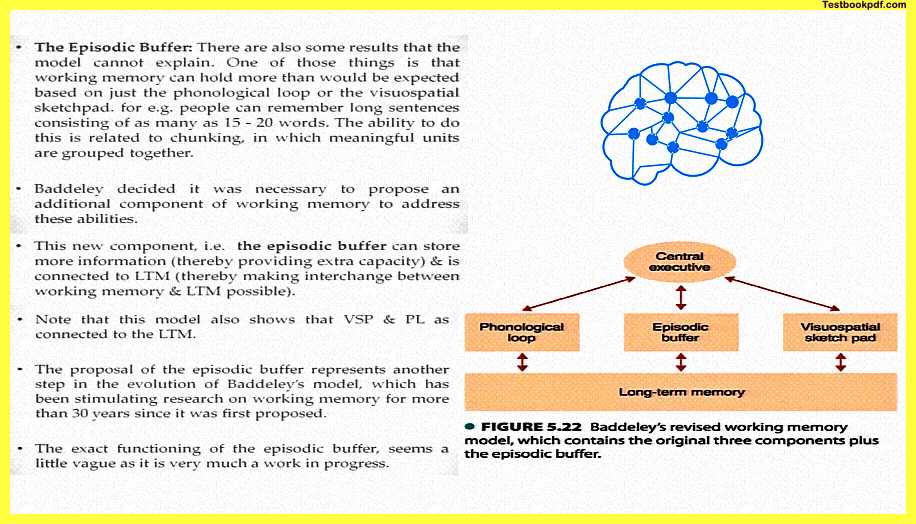
Now the episodic buffer basically is something it is basically one aspect of Working memory that can hold more than it would be expected based on just the phonological loop or the Visuospatial Sketchpad so for to account for the extra information that is held in the Working memory one might one has proposed what is called the episodic buffer, for example, people can remember long sentences of consisting as many as 15 to 20 words now the ability to do this is achieved via chunking which we have talked about earlier in which meaningful units have been lumped together have been joined together.
Now badly decided that it was necessary to propose an additional component of Working memory like the episodic buffer to address these different kinds of abilities which are not being explained already by the phonological store and the Visuospatial Sketchpad this new component is the episodic buffer can store more information thereby providing extra capacity and is already connected to the long-term memory thereby making this exchange between long-term memory and Working memory possible because even if you are working at new information even if you are manipulating new objects in the world which you are being given you are certainly drawing upon the scale and experiences that you have gained and that is stored in the long-term memory here is the complete model of Alan David Baddeley’s Working memory model and here in you can now see all the four components.
So there is the central executive there is the phonological loop there is the episodic buffer and the Visuospatial Sketchpad and each of these in their own way will interact with the long-term memory this is a complete model which has been used to explain so many findings so many research findings from Working memory now note that this model also shows that Visuospatial Sketchpad and phonological loop also are connected to the long-term memory now the proposal of the episodic buffer represents one step in the evolution of badly’s a model because the initial model did not have the episodic buffer provided for this has been stimulating research in memory for over 30 years since it was first proposed in the 1970s now the exact functioning of the episodic buffer still seems a little vague it is not really been completely specified but it is supposed to be a very important aspect.
How Working memory is specified in the human brain?
Now there have been quite a few ways in which people wanted to study how does memory really exist in the brain or how do you look at the brain and say something about Working memory now four of these things have been done say for example analysis of the behavior after brain damage when people have brain damage in areas which are supposed to be related to memory per se recordings have been done from single neurons single cell recordings this is this is basically limited to animals and not really humans then EEG signals which is electroencephalography if you remember the methods chapter i have talked about that if you remember the methods chapter i have talked about it might be a good time to go back and refer to them now one of the tasks was done with the monkeys so the delayed response task now early research on frontal lobe memory was carried out in monkeys using what is called the delayed response task basically this task required the monkey to hold information in their Working memory during a delay period so that is why delayed response task.
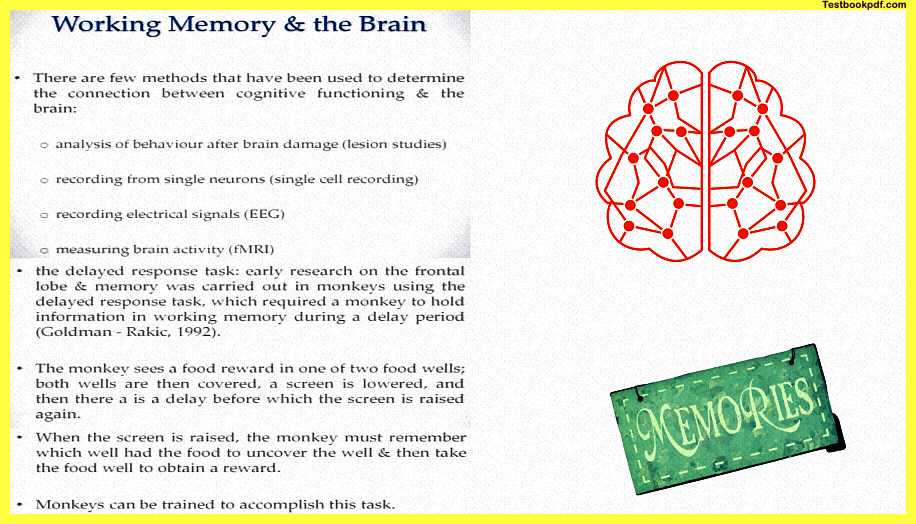
Now what happens in this task is that monkey sees a food reward in one of two food wells where the monkey is inside the cage there are two food wells outside the monkey’s cage and both whales are covered monkey sees that the food reward is kept in one and then they are covered and then a screen is lowered so that the monkey cannot see where this is so you cannot maintain that information and then after this delay the screen is raised what the monkey has to do is that it must remember which of the food well had already received the food before it was covered and then uncover that well and take the food out and eat it that is very simple and monkeys can be trained to accomplish this task this is the setup of this particular task now however when the prefrontal cortex was removed their performance monkey’s performance dropped to the level of chance and they were found to be correct only 50 percent of the time.
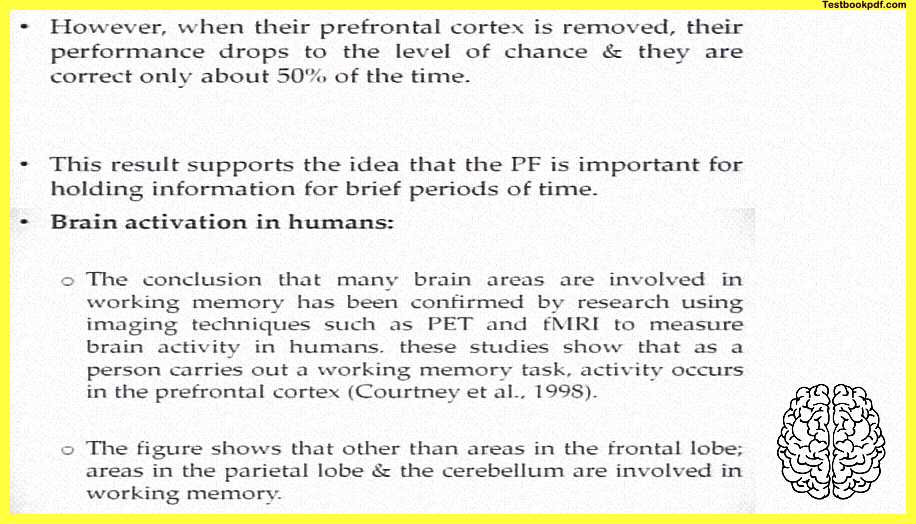
Now this basically supports the idea that the prefrontal cortex is very important for holding information for brief periods of time does this happen in humans as well are these the same areas in humans as well?
So people have also investigated brain activation in humans now the conclusion that many brain areas are involved in Working memory has been confirmed by research using neuroimaging techniques such as p e t that is positron emission tomography and functional fmr and functional MRI basically the idea is to measure the brain activity in humans in response to tasks which involve memory or Working memory.
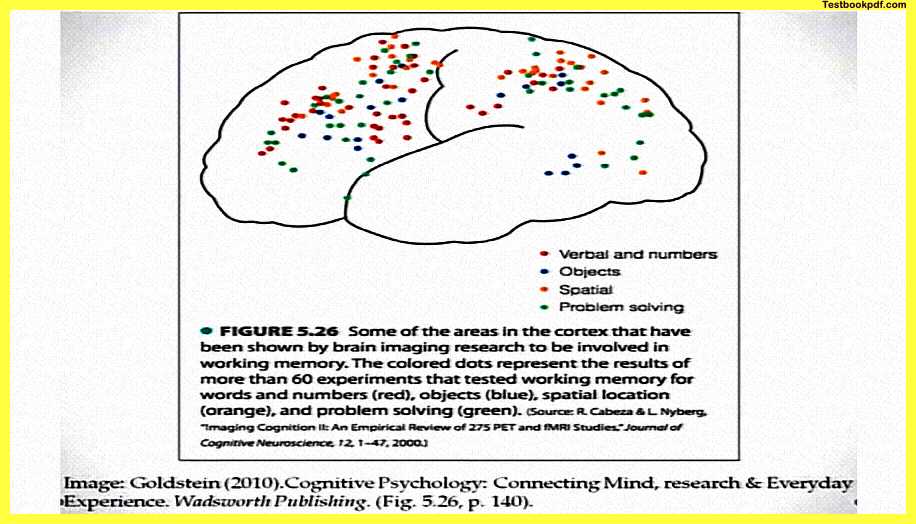
Now here is the figure shows that what are the different areas found in humans which are found to be involved in memory operations you will see that there are particular areas that are involved with verbal and numeric information other areas involved with objects information other areas with spatial information and problem-solving all of this is very well demonstrated in this figure from Goldstein’s book now Voegelin coworkers they did an experiment on the allocation of attention by measuring a component of ERP in humans which is recorded during a Working memory task now the response they were measuring was related to encoding the number of items in Working memory.
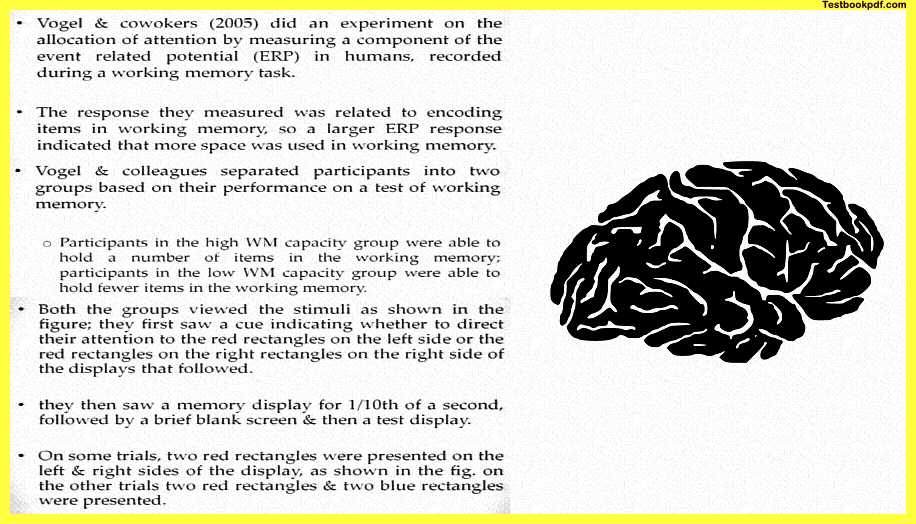
So, a larger ERP response would indicate that more space was used in Working so they previously on the basis of previous research determined which component generally is involved in Working memory, and then they were doing this test to see if the task we are giving involves more or less Working memory so Vogel includes separated participants into two groups based on their performance on a particular test of Working memory.
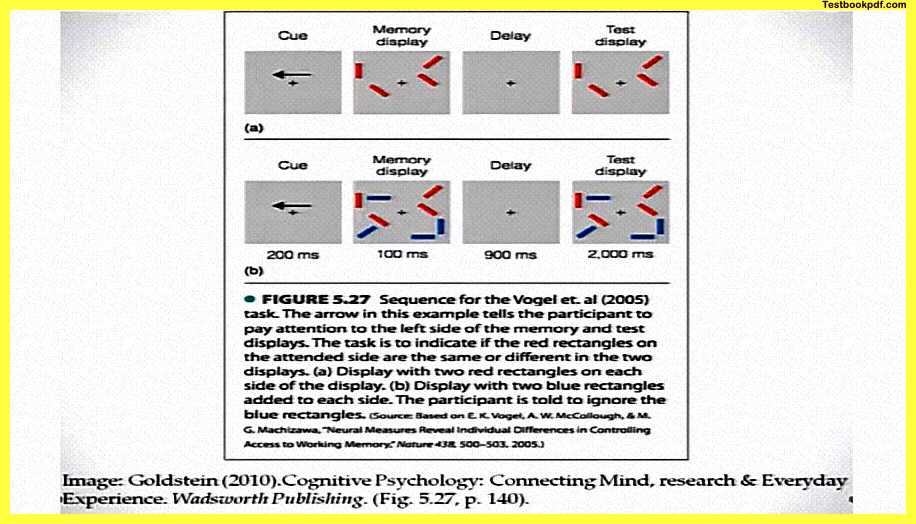
Now participants in the high Working memory capacity group those who had higher Working memory capacity were found that they were able to maintain a larger number of items in Working memory as compared to participants with low Working memory capacity both the groups viewed the stimuli as shown in the figure I will just show you the figure right now and they first saw a queue indicating whether to direct their attention to the left side red triangles on the left side of the red triangles on the right side of the displays and then they saw a memory display for around one-tenth of a second followed by a brief blank screen and then it was a test display.
Now on some trials what happens is that I will just show you the figure so this is the thing there is a fixation cross and there is a queue and then there is the memory display when they have to remember where this red rectangle is and then there is a delay and then there is a test display ok so they have to determine whether red rectangles are still there or not now on sometimes the red the two red rectangles presented on the left and right side of the screen as shown in the figure here in panel a but on a few other trials, two blue rectangles were also present they were also added to this entire array here you can see trial panel b wherein the blue rectangles have also been added in addition to the already present red rectangles.
So the amount of work in maintaining this will slightly become harder so the participant’s task, here again, was to respond to the test display by indicating whether the orientations of the red rectangles on the queued side of the test display were the same or different than of the memory display so they would have to maintain both that it is a rectangle and its orientation.
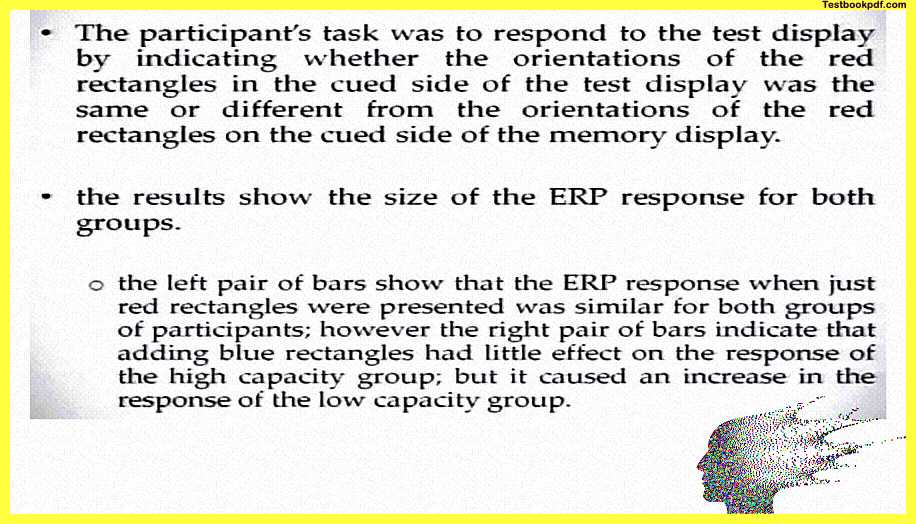
Now the results show that the size of erp for both groups they kind of try and compare the size of the erp component for both the groups the left pair of bars here shows that when there were two red rectangles it was still a higher response for the low Working memory capacity group but a good but a lower response for a high Working memory capacity group but if you see in the second panel in the right pair of bars you will see that addition of two blue rectangles does not increase the response too much in the high Working memory capacity groups but it kind of causes a drastic change in the response in the erp response of the low Working memory capacity group so what is basically happening here is that by addition of two extra red blue rectangles in the display you are increasing the amount of effort in the participants and the low Working memory capacity participants because this task involves ignoring the blue rectangles as distractors the low Working memory capacity participants are finding it hard to ignore that and that is why their erp response to this task the one shown in panel b here is much higher .
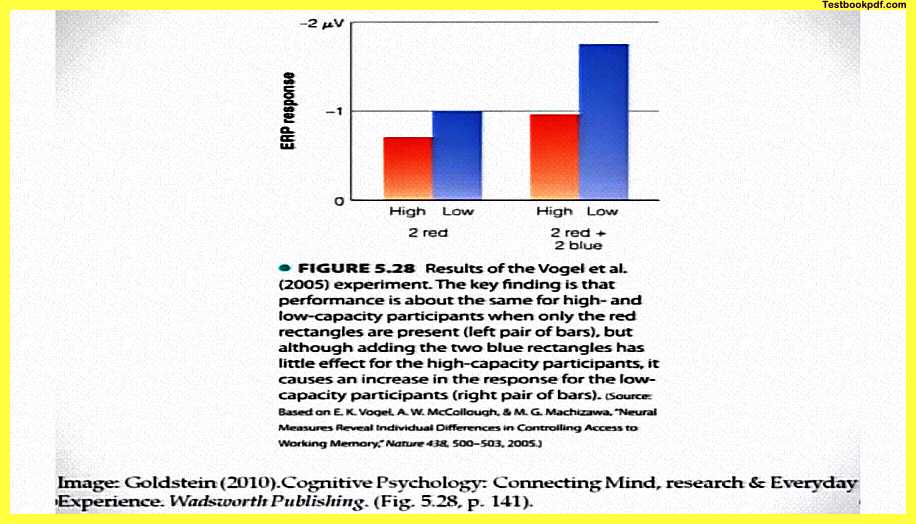
Now the fact that adding the two blue rectangles had little effect on i am just kind of repeating this so that you kind of follow this so the fact that adding the two blue rectangles had little effect on the response of high capacity group means that these participants were very efficient at ignoring the distractors so the irrelevant blue stimuli did not do much damage to them did not take up any space in their Working memories this means that the central executive was functioning well for these participants the fact that adding the two blue rectangles caused a large increase in the response of the lower Working memory capacity group means that these partitions were not able to sufficiently and properly ignore the blue rectangles which were anyways irrelevant to the task because the task is not changed so it tells us blue rectangles were acquiring a lot of space in their Working memory and their central executive was not operating as efficiently as that of the higher Working memory capacity group.

Now, what can we conclude from this we can conclude that Vogel and colleagues basically conclude that some people’s central executives might be better than others at allocating attention and at controlling this whole workflow information during a particular task.
Personal Opinion and Notes –
WORKING MEMORY
Alan David Baddeley proposed that memory processes must be dynamic and they must also consider the number of components that can function separately. Gave birth to this idea of Working memory, Working memory is defined as a limited capacity system for temporary storage & manipulation of information.
(Baddeley & Hitch 1974)
The Working memory accomplishes the manipulation of information through the action of three components: the phonological loop, the Visuospatial Sketchpad & the central executive.
The phonological loop consists of two components:
- the phonological store, which has a limited capacity and holds information for only a few seconds.
- the articulatory rehearsal process, which is responsible for rehearsal that can keep items in the phonological store from decaying.
The phonological loop holds verbal and auditory information.
The Visuospatial Sketchpad holds visual and spatial information, The central executive is where the major work of Working memory occurs. The central executive pulls information from the LTM and coordinates the activity of the PL & VSSP by focusing on specific parts of a task and switching attention from one part to another, One of the main tasks of the central executive is to decide on how to divide attention between tasks.
The Phonological Loop:
The Phonological Similarity Effect- the confusion of letters/words that sound similar (remember Conrad’s experiment)
(Baddeley et al 1984) the Word Length Effect- occurs when memory for lists of words is better for short words than for long words.
(Baddeley 2000) Articulatory Suppression- one of these ways where operation of the phonological loop can be disrupted, occurs when a person is prevented from rehearsing some verbal information by asking them to repeat an irrelevant sound. This particular phenomenon occurs because you cannot maintain too much verbal information at the same time in the phonological loop.
(speaking interferes with rehearsal) (Baddeley et al 1984) repeating irrelevant information not only reduces the ability to remember a list of words but also eliminates the word length effect.
The Visuospatial Sketchpad:
Handles visual & spatial information, and is therefore involved in the process of visual imagery. (Shepard & Metzler 1971) mental rotation of objects occurs to compare (Brooks 1968).
If you like this article please share it with your friends, Thank you for Reading this article.
Read also:
